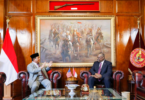BRUSSELS (The Hill); The threat of a Russian invasion of Ukraine has sent NATO countries scrambling to provide military support to Kyiv.
In recent weeks, Spain, France, Estonia, the United Kingdom and the U.S. among others have provided varying kinds of military support to Ukraine in anticipation of Russian aggression.
NATO is under no treaty’s obligation to defend Ukraine because the ex-Soviet country is not a member of the alliance, but the group has made clear that it stands with Kyiv and has called on Moscow to de-escalate tensions.
Some military movements appear to be posturing, aimed at deterring Russia from any aggressive actions, but other steps appear to be prepared for a serious conflict. Either way, experts say, the assistance could show Russian President Vladimir Putin that the cost of an invasion of Ukraine is too great.
“There’s clearly a sense that the military support provided to Ukraine would help Ukraine raise the cost to Russia of military aggression,” said former U.S. Ambassador William Courtney, a senior fellow at RAND Corporation.
Ukraine has asked to join NATO, a move that is staunchly opposed by Russia. Russian officials have demanded that NATO not extend further east, but the alliance has rebuffed these demands. The Kremlin has used this refusal as a justification to amass forces at the border, claiming unspecified security concerns.
Russia has amassed at least 100,000 troops near its border with Ukraine, and U.S. officials have warned that an attack could likely occur by mid-February.
In recent years, the Ukrainian forces have been able to increase operability and protect itself against another invasion. Still, the Russian military is far more dominant and capable than its opponent.
Courtney confirmed that NATO has no formal obligation to defend Ukraine, but added that the West’s military support to the Eastern European country has been “quite substantial” since 2014.
At the time, Russian forces invaded and annexed the Crimean Peninsula.
“Europe and the United States, over time, developed an increasing desire to help Ukraine advance internally both through reforms democratic and economic reforms, and also to move closer to the West which seems to be Ukraine’s interest,” he said.
One goal of aiding Ukraine is centered around the concept of “porcupine defense,” the idea that a country makes itself as difficult to invade as possible.
“You provide security assistance and arms that are lethal that complicate Russia’s ability to take large parts of Ukraine without getting beaten up in the process,” said Rachel Ellehuus, deputy director of the Europe, Russia and Eurasia program at the Center for Strategic and International Studies.
“So, they can certainly withstand a Russian incursion for a limited period of time, but not forever,” she continued.
This method, combined with the alliance’s threats of severe economic consequences should Russia invade, could make Putin think twice about doing so.
“The issue is helping to deter Russian aggression by making clear that the cost to it economic, military and the human costs of casualties will be greater than maybe expected before,” Courtney said.
While the alliance is behind Ukraine, countries thus far have varied on the extent of their support.
Over the past couple of weeks, Denmark decided to send four additional F-16 fighter jets to Lithuania for air policing and a 160-man frigate in the Baltic Sea. France, for its part, has offered to send troops to Romania.
The United Kingdom also announced that it is sending Ukraine light, anti-armor defensive weapons systems, as well as a small number of U.K. personnel to provide training.
Meanwhile, Estonia, Latvia and Lithuania recently received approval from the U.S. to send American-made weapons to Ukraine for additional defense.
Estonia is providing Javelin anti-armor missiles, while Latvia and Lithuania are providing Stinger anti-aircraft missiles and adjacent equipment.
“We sincerely hope that Ukraine will face no need to use this equipment and call on Russian Federation to seize its aggressive and irresponsible behavior,” the Baltic nations said in a statement.
Spain announced Thursday that it is sending warships to bolster NATO’s naval forces in the Mediterranean and Black Seas and is mulling sending its own fighter jets to Bulgaria.
But countries sending assistance must strike a delicate balance — helping Ukraine without doing anything that could provoke the Kremlin.
Charles Kupchan, a senior fellow at the Council for Foreign Relations, explained that recent efforts to provide assistance have been defensive in nature for this reason.
“Given that diplomacy continues and that the preferred outcome by NATO countries is a diplomatic resolution to the conflict, NATO members are trying to find the right balance between improving the capabilities of the Ukrainian military to resist Russian aggression and taking steps that the Russians would see as a provocation,” Kupchan said.
Further complicating matters is uncertainty about how Russia would invade Ukraine, should it choose to do so.
Moscow has largely positioned troops along Ukraine’s northeastern border. On Tuesday, it announced that it’s moving troops to Belarus for military drills that are scheduled for next month, when the West fears an invasion could occur.
The drills put more pressure on NATO nations, as it puts Russian troops on Ukraine’s northern neighbor, giving Putin more options for a possible invasion.
“I think the dynamic really changed when Russia sent forces into Belarus,” Ellenhuus said. “A lot of allies now worry that Russia is somehow preparing to invade Ukraine, both from the south and then also from, from Belarus.”
A Russian invasion of Ukraine could trigger a rush to ensure that countries on its eastern flank are defended.
The U.S., for its part, has no intentions of sending troops to deter an invasion, but has said if Russia invades, then it would send troops to bolster NATO’s forces along the Eastern Flank.
President Biden has also repeated several times in recent weeks that if Russia decides to invade Ukraine, the U.S. will slap devastating economic sanctions on the country. Vice President Harris echoed this same sentiment in an interview with Savannah Guthrie earlier this week.
The U.S. military has already sent the USS Harry S. Truman aircraft carrier strike group to take part in a NATO naval exercise in the Mediterranean, though Pentagon officials insist the drill are not in response to Russia’s recent aggressions.






